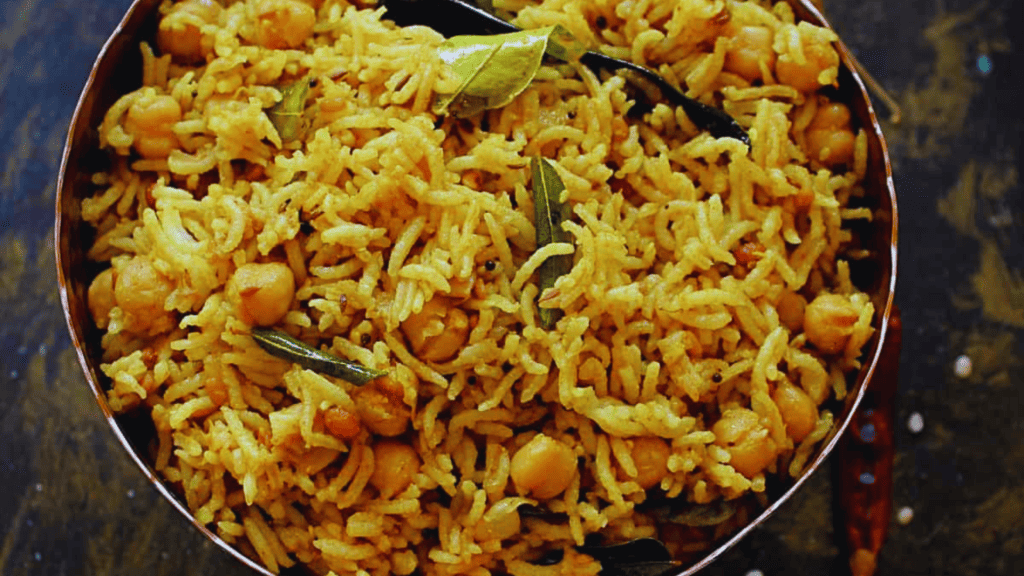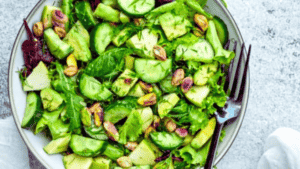The classic South Indian meal tamarind rice, also called “puliyodarai” or “pulihora,” is well-known for its acidic and savory flavor. A delightful and fragrant rice meal is produced by mixing cooked rice with a special combination of spices and tamarind pulp. Read on to know more about this easy tamarind rice recipe.
About Tamarind Rice Recipe
In South Indian cuisine, tamarind rice is often served as a main course meal. It can be eaten by itself or with yogurt, raita (a side dish made of yogurt), or a pickle. It is frequently cooked for festivals, important events, or as a component of a typical South Indian dinner.
| Time | Difficulty | Serves |
| 30 Minutes | Easy | 2 |
How To Make Tamarind Rice at Home (Step Wise)
Here’s how to make tamarind rice in brief, easy steps:-
Step 1: Cook the rice separately and set it aside to cool.
Step 2: Extract the pulp from the soaked tamarind by squeezing it in water. Strain the pulp to remove any seeds or fibers.
Step 3: Heat oil in a pan or kadai (Indian wok) on medium heat.
Step 4: Add mustard seeds and let them splutter.
Step 5: Add cumin seeds, dried red chilies, and a pinch of asafoetida. Sauté for a few seconds.
Step 6: Add the tamarind pulp to the pan and mix well with the spices. Cook until the raw smell of tamarind disappears and the mixture thickens slightly.
Step 7: Add turmeric powder and salt to the tamarind mixture and mix well.
Step 8: Add the cooked rice to the pan and gently mix it with the tamarind mixture until all the rice is well-coated.
Step 9: Optional: In a separate pan, fry cashews or peanuts until golden brown. Add them to the rice and mix well.
Step 10: Remove from heat and let the flavors meld for a few minutes before serving.
Preparation for Tamarind Rice Recipe
Here’s what you need to be prepared to make this easy tamarind rice recipe:
- Cook the rice separately and let it cool.
- Soak the tamarind ball in warm water, extract the pulp, and strain it.
- Measure out the oil, mustard seeds, cumin seeds, dried red chilies, asafoetida, turmeric powder, and salt.
Ingredients for Tamarind Rice Recipe
Let’s look at the ingredients for the easy tamarind rice recipe:
- 2 cups cooked rice
- 1 lemon-sized tamarind ball (soaked in warm water)
- 2 tablespoons oil
- 1 teaspoon mustard seeds
- 1 teaspoon cumin seeds
- 2 dried red chilies
- A pinch of asafoetida
- 1/2 teaspoon turmeric powder
- Salt to taste
Optional:
- Cashews or peanuts (for garnish and crunch)
Method/Steps for Cooking Tamarind Rice Recipe
Let’s understand how to make tamarind rice by following these steps:
Step 1: Cook the Rice:
- Rinse 1 cup of rice thoroughly and cook it separately according to your preferred method.
- Once cooked, spread the rice out on a plate or tray to cool and separate the grains.
Step 2: Prepare the Tamarind Pulp:
- Take a lemon-sized tamarind ball and soak it in warm water for about 15-20 minutes.
- Squeeze the soaked tamarind to extract the pulp, and strain it to remove any seeds or fibers. Set aside.
Step 3: Sauté the Spices:
- Heat 2 tablespoons of oil in a pan or kadai (Indian wok) over medium heat.
- Add 1 teaspoon of mustard seeds and let them splutter.
- Add 1 teaspoon of cumin seeds, 2 dried red chilies, and a pinch of asafoetida. Sauté for a few seconds until the spices release their aroma.
Step 4: Add Tamarind Pulp and Spices:
- Pour the prepared tamarind pulp into the pan with the sautéed spices.
- Mix well and cook the mixture until the raw smell of tamarind disappears and the mixture thickens slightly.
Step 5: Season the Rice:
- Add 1/2 teaspoon of turmeric powder and salt to taste into the tamarind mixture. Mix well.
Step 6: Combine Rice and Tamarind Mixture:
- Add the cooked rice to the pan with the tamarind mixture.
- Gently mix the rice with the tamarind mixture, ensuring all the rice grains are well-coated. Be careful not to break the rice grains.
Step 7: Optional: Garnish with Nuts:
- In a separate pan, fry a handful of cashews or peanuts until they turn golden brown.
- Add the fried nuts to the rice and mix well for added flavor and crunch.
Step 8: Serve:
- Remove the pan from heat and let the flavors meld for a few minutes.
- Tamarind rice is now ready to be served.
Any Alternate Way to Make Tamarind Rice Recipe
People often wonder how to make tamarind rice interesting. Here, we’ll look at an alternate easy tamarind rice recipe that is packed with nutrition and taste.
Step 1: Cook the rice separately and let it cool.
Step 2: Prepare the tamarind rice paste by sautéing mustard seeds, cumin seeds, dried red chilies, asafoetida, and tamarind pulp. Cook until it forms a thick paste. Let it cool.
Step 3: Heat oil in a pan and sauté mustard seeds, cumin seeds, dried red chilies, and asafoetida.
Step 4: Add the tamarind rice paste to the pan and cook for a minute.
Step 5: Add the cooked rice to the pan and mix well to coat the rice with the tamarind paste.
Step 6: Adjust salt if needed.
Step 7: Remove from heat and let the flavors meld for a few minutes.
Step 8: Tamarind rice prepared using the alternate method is now ready to be served.
Nutritional Value in Tamarind Rice Recipe
Here’s an approximate nutritional breakdown for an easy tamarind rice recipe (serves 2):
| Nutrient | Quantity per Serving |
|---|---|
| Calories | 300-350 kcal |
| Protein | 4-6 grams |
| Carbohydrates | 60-70 grams |
| Fat | 6-8 grams |
| Fiber | 2-4 grams |
Pro Tips to Make the Best Tamarind Rice Recipe at Home
Here are some pro tips on how to make tamarind rice recipe at home:
- Use freshly cooked and cooled rice for the best texture and flavor.
- Soak the tamarind in warm water for a sufficient amount of time to extract maximum pulp.
- Adjust the amount of tamarind pulp according to your preference for tanginess.
- For extra flavor, roast the spices before adding them to the dish.
- Add a pinch of jaggery or sugar to balance the tanginess of the tamarind.
Health Benefits of Tamarind Rice Recipe
This easy tamarind rice recipe offers several health benefits:
- Rich in antioxidants: Tamarind contains antioxidants that help protect the body against damage caused by harmful free radicals.
- Good source of vitamins and minerals: Tamarind is a good source of various vitamins and minerals, including vitamin C, potassium, magnesium, and iron. Read more about nutrient-rich foods.
- Digestive health support: Tamarind has natural fiber that can aid in digestion and promote a healthy digestive system. Read more about digestive health.
- Potential anti-inflammatory properties: Tamarind contains compounds that have been associated with anti-inflammatory effects, which may help reduce inflammation in the body.
- May aid in weight management: Tamarind rice, when consumed as part of a balanced diet, can provide a satisfying and flavorful meal while being relatively low in calories. (Check out our weight loss plans)
Tips to Limit the Calorie in Tamarind Rice Recipe
Here are some tips on how to make a tamarind rice recipe with fewer calories:
- To get more fiber and fewer calories, use brown rice or quinoa in place of white rice.
- Use a non-stick pan and use as little oil as possible while sautéing.
- To save calories, cut back on the amount of nuts or skip them altogether.
- Instead of using fried spices, go for roasted or dry-roasted ones.
- To spread the flavor without increasing the calorie count, dilute tamarind pulp with water.
What’s Different in the Tamarind Rice Recipe by Livofy?
Tamarind Rice recipes can differ in terms of ingredients, preparation methods, and flavors. Each recipe may have its own unique combination of condiments to create delicious and nutritious tamarind rice. The complexity and cooking time can vary, allowing you to choose a recipe that fits your schedule. Trying out different recipes will help you discover your preferred version of tamarind rice that suits your taste buds and dietary preferences.
FAQs
What is the cooking time for the Tamarind Rice recipe?
It takes about 30 minutes to cook this tamarind rice recipe.
Is Tamarind Rice healthy?
When made with quinoa or whole grain rice, lots of veggies, and little oil, tamarind rice may be a nutritious option. When consumed in moderation as part of a balanced diet, it provides the advantages of antioxidants, fiber, and maybe anti-inflammatory characteristics, making it a healthy and delectable dish.
How many calories does the Tamarind Rice recipe have?
Tamarind rice’s calorie count might change based on the exact components and serving sizes utilized. A serving of tamarind rice (about 1 cup) typically has between 300 and 400 calories. It’s crucial to remember that the number of calories might vary depending on several elements, including the kind of rice used and the amounts of oil and other ingredients used during cooking.
How to make Tamarind Rice recipe interesting?
Here’s how to make tamarind rice recipe interesting:
Consider adding more flavors and textures to the tamarind rice dish to make it more intriguing. Sprinkle toasted sesame seeds or roasted cumin powder for more flavor and scent, add roasted peanuts or cashews for crunch, and garnish with fresh cilantro or shredded coconut for additional freshness. The flavor and presentation of tamarind rice may be improved with these straightforward additions, making it a more alluring and satisfying dish.
Are there any side effects of Tamarind Rice?
Tamarind rice is generally safe to consume, but it is important to note that excessive consumption of tamarind can cause some side effects. The high acidic content in tamarind may irritate the stomach lining in some individuals, leading to digestive discomfort. Additionally, tamarind is a natural laxative, and consuming large amounts may result in loose stools or diarrhea. It is recommended to consume tamarind rice in moderation and consult a healthcare professional if you have any specific concerns or pre-existing digestive conditions.
How to make Tamarind Rice with maximum flavor?
Here’s how to make tamarind rice with maximum flavor:
To make tamarind rice with maximum flavor, soak tamarind pulp in warm water for an extended period to extract maximum tanginess. Roast the spices before adding them to the dish for enhanced aroma. Allow the cooked rice to sit with the tamarind mixture for some time to absorb the flavors fully. These steps will help create a tantalizing and flavorful tamarind rice dish.
How to make Tamarind Rice with a spicy twist?
Here’s how to make tamarind rice with a spicy twist:
To give tamarind rice a spicy twist, add finely chopped green chilies or red chili powder while sautéing the spices. Increase the quantity of black pepper or add a pinch of cayenne pepper for an extra kick of heat. Adjust the spice levels according to your preference to create a deliciously spicy tamarind rice variation.
How to make Tamarind Rice gluten-free?
Here’s how to make tamarind rice gluten-free:
Utilise gluten-free products to make tamarind rice. Use coconut aminos or gluten-free tamari in lieu of conventional soy sauce. To prevent cross-contamination, make sure that every spice, condiment, and serving of rice used in the dish is marked gluten-free.









